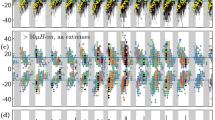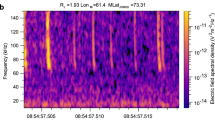Abstract
ON my return to Newcastle-on-Tyne I take the opportunity of being able to recur to books of reference to reply to a question put by Mr. Procter, in NATURE (vol. x. p. 355), whether any complete catalogues of auroras have been constructed, and if they show indications of periodicity in its displays. Kæsemtz's “Meteorology,” in which almost every feature of the weather capable of being chronicled has been fully catalogued, probably contains a list more or less complete, up to its author's time, of all then known descriptions of auroras. If this be so, it has probably served for the groundwork upon which later and more complete catalogues have been compiled, extended, and completed in his own and other countries. Dr. Heis, the director of the Prussian Observatory at Münster, in Westphalia, is especially active in collecting information of the slightest appearances of aurora in any quarters of the globe, from whence published or private descriptions of them can be obtained. Every successive number of such works as Mr. G. J. Symons's Monthly Meteorological Magazine and the Quarterly Journal of the Scottish Meteorological Society contains, in a few pages of “meteorological notes” on the weather peculiarities of each month from their numerous observers, a list of scattered aurora-observations, which is probably as complete for the British Isles during the years in which these publications have been carried on, as the perfect or partial clearness of the sky over this country, and indeed over some adjacent continental stations, enables such a list to be made by observations. But this collection, invaluable as it is for our own immediate field of registry, I is not assorted, nor suited, without extension by the help of similar collections made in surrounding foreign countries, to be regarded as a sufficiently extensive list of auroras for dealing generally with the question of their periodicity. The present state of progress of our knowledge, with regard to auroral frequency, we owe largely, if not almost entirely, to the researches of Prof. E. Loomis, of Yale College, U.S., the results of whose discussion of the collateral views and considerations involved in them will be found in numbers of the American Journal of Science for July 1860, Sept. 1870, and April 1873. In the first of these papers, a map of lines of equal auroral frequency for the northern hemisphere is presented, dividing the northern area of the globe into zones encircling the arctic regions. It appears, for example, from this map, that auroral displays are not very much more frequently visible in St. Petersburg than they are in London, and that even Boston and Edinburgh are as frequently visited by them as the great northern capital itself. An oval belt of greatest auroral frequency encloses together the northgeographica and north magnetic poles, covering all the European, Asiatic, and American coast lines of the Arctic Ocean, and passing onwards from the latter across Hudson's Bay, the mouth of Baffin's Bay, and Iceland, back to the North Cape. For a short distance within this ample belt auroras continue to be tolerably frequent, and grow comparatively more scarce in Smith's Sound and the northern parts of Baffin's Bay, and indeed apparently in proportion as the geographical north polar regions are approached.* It is with the outer and not with the inner margin, however, of this ring-maximum of auroras that observers in ordinary latitudes are concerned, and it is pointed out in his most recent paper by Prof. Loomis, that in constructing general catalogues for deciding questions of auroral periodicity, a line, or at least a restricted zone, bordered northwards and southwards by lines of equal auroral frequency, should be chosen as the localities from which observations may be gathered. To place this line or belt in the zone itself of almost constant auroral activity, where auroras can only vary periodically in brightness rather than in frequency, would be of no avail for enumerations; the zone selected must be one of occasional auroras, arising only from the southward spreading of the strongest disturbances of the ever-beaming and sometimes forth-sallying illuminations of the north.
This is a preview of subscription content, access via your institution
Access options
Subscribe to this journal
Receive 51 print issues and online access
$199.00 per year
only $3.90 per issue
Buy this article
- Purchase on Springer Link
- Instant access to full article PDF
Prices may be subject to local taxes which are calculated during checkout
Similar content being viewed by others
Rights and permissions
About this article
Cite this article
HERSCHEL, A. Periodicity of Auroras. Nature 10, 500–502 (1874). https://doi.org/10.1038/010500b0
Issue Date:
DOI: https://doi.org/10.1038/010500b0
Comments
By submitting a comment you agree to abide by our Terms and Community Guidelines. If you find something abusive or that does not comply with our terms or guidelines please flag it as inappropriate.



